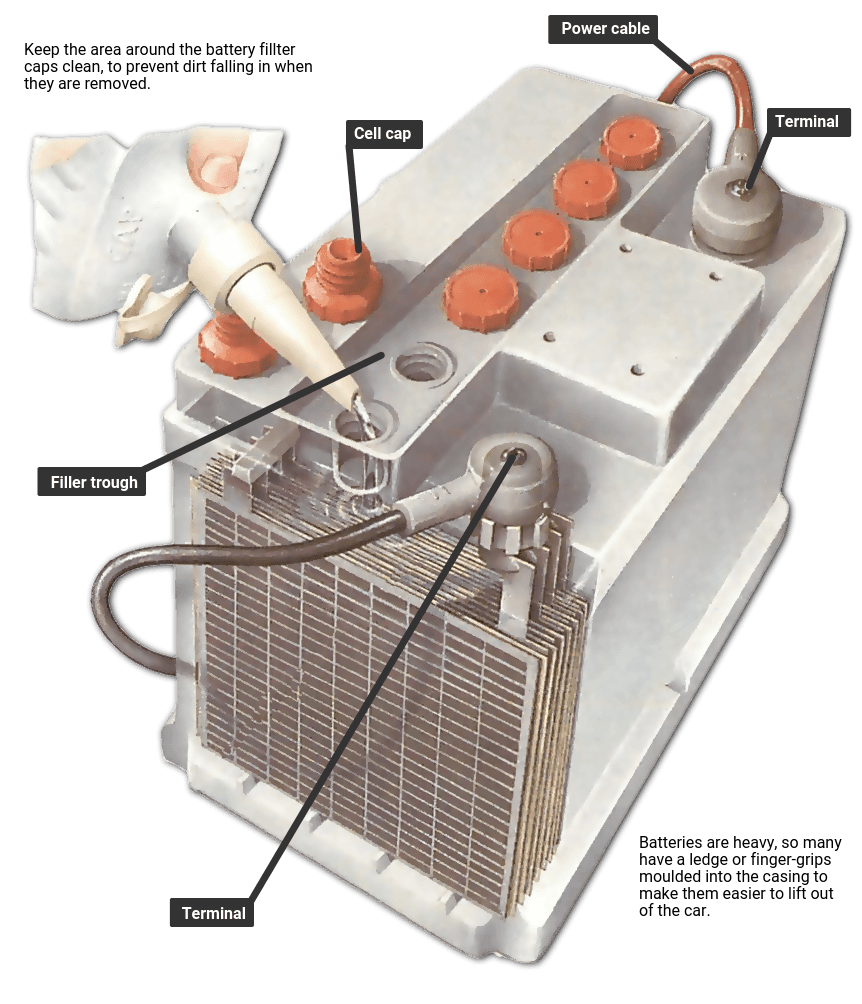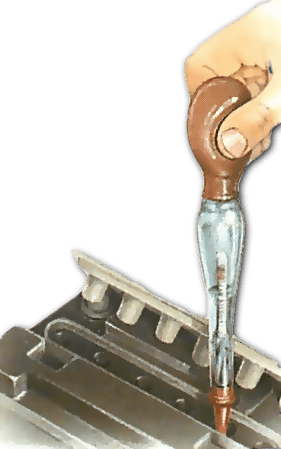Checking the batteries
The Video Course teaches you everything about modern cars.

Most car batteries are sealed for life - apart from a small vent hole which allows gas to escape. They never need topping up.
The fluid level in other batteries should be checked at least once a month and topped up if it drops below the correct level - just above the tops of the battery plates .
Never top up with tap water, which contains minerals which may damage the battery. Use distilled or otherwise purified water, or a proprietary topping-up fluid.
Avoid over-filling, which causes the electrolyte to leak out through the cell-cap vents as the battery is charged.
Do not use a naked flame when checking the battery. The fluid inside - called the electrolyte - can give off explosive gas, especially soon after the battery has been charged.
The electrolyte is a mixture of sulphuric acid and purified water, and is corrosive and dangerous. Do not allow any to splash on to your skin or your clothing.
If you are splashed, wash the affected skin area immediately. If it goes in your eye, wash thoroughly in running water and call a doctor.
If electrolyte splashes on to your car, hose it off immediately.
A drop in the battery fluid level is caused - provided that there are no leaks - by evaporation of the water in the electrolyte mixture.
Once the level falls below the tops of the battery plates , the cell concerned starts to lose efficiency.
If the cell is left for some time with the plates exposed, it can be damaged. That in turn will ruin the battery, which needs all its cells functioning to retain its full electrical charge and deliver power. The battery must be replaced.
How quickly the electrolyte evaporates depends a great deal on two factors: the under-bonnet temperature (if the battery is located there); and whether the generator is overcharging the battery.
Generally, the higher the temperature the more frequently a battery may need topping up. In most cases, the monthly check is enough - but check more often in hot weather, or if the level is well down at the monthly check. Battery cases rarely leak. If more than the usual amount of topping up suddenly becomes necessary, look for the cause.
If a charging-system fault is overcharging the battery, you may find damp patches around the cell caps and even droplets of electrolyte on the battery top (See How to test a car battery ).
How to top up a battery
Remove the cell caps or trough cover and fill each cell to the level marked on the battery case. If there is no mark, fill until the electrolyte just covers the battery plates, which you can see through the filler holes.
Apart from distilled or otherwise purified water, proprietary topping-up fluids are available from garages, accessory shops and sometimes chemists. Buy them only in sealed containers, to be sure that they are not contaminated.
As an alternative, water from a de-frosted refrigerator can be used, but it must be kept in a clean glass jar or bottle.
Always keep the battery top clean - wipe it before removing the cell caps or trough cover, when dirt is liable to fall into the cells.
The cell caps or cover have ventilating holes to allow the escape of gases when the battery is being charged. Make sure these holes are clear.
After topping up, wipe away any water spilled on the top of the battery.
Using a hydrometer

You can find out how well a battery is charged by measuring the specific gravity - or density of the electrolyte, which varies according to the state of charge.
The specific gravity is the weight of a specific volume of liquid compared with that of the same volume of water.
The figure for electrolyte in a fully charged battery is between 1.270 and 1.290 - meaning that it is 1.270 times heavier than water.
However, as the battery loses charge, the specific gravity drops to 1.130 or lower.
The instrument for measuring specific gravity is a hydrometer , which contains a weighted float . The float is marked with a graduated scale , usually reading from 1.10 to 1.30.
Insert the syringe into a cell, then squeeze and release the bulb to draw up a sample of electrolyte - enough to raise the float but not enough to make it touch the bulb.
Read off the graduation mark which is level with the surface of the electrolyte.
The state of charge can be gauged from how much the figure is below 1.290. A reading of, say, 1.200 would show the battery to be about half charged.
The float may be graded red, yellow and green to show low, half or full charge. Some hydrometers have three small balls of different weights instead of a float. The number of balls that float to the top of the sample indicate the state of charge.
After taking the reading, squeeze the bulb to return the electrolyte to its cell, and test the other cells in turn. All should give similar readings within about 0.04 of each other - any greater variation indicates a defective cell, and the battery must be replaced.
The best time for testing is after the battery has been charged or the car run for about 30 minutes. Switch off the engine and lights.
The Ultimate Car Mechanics video course
Learn everything about modern cars from our new video series.
Learn more >-
We build a Mazda MX5 Miata from scratch
We start by tearing down and then rebuilding the whole car.
-
Every part explained
There's ridiculous detail on every part. Clearly and easily explained.
-
All modeled in 3D
We've created the most detailed 3D model ever produced so we can show you everything working.






